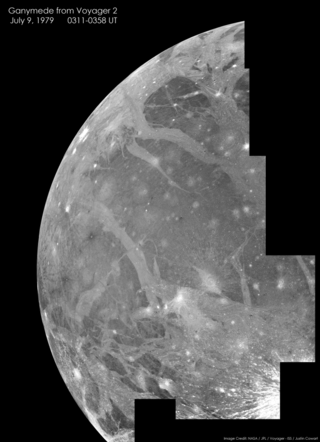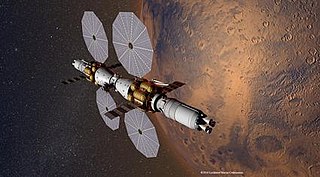

Mars orbit rendezvous (MOR) is a space travel concept where two spacecraft meet up and/or dock in Mars orbit. [1]


Mars orbit rendezvous (MOR) is a space travel concept where two spacecraft meet up and/or dock in Mars orbit. [1]
For example, one vehicle takes off from Mars, such as a Martian ascent stage, and does a rendezvous in Mars orbit with another spacecraft. [1] Applied to a Mars sample return or human mission to Mars, it allows much less weight to be sent to the surface and back into orbit, because the fuel needed to travel back to Earth is not landed on the planet. [1] It has also been proposed for uncrewed Mars sample return plans. [2] [3]
In one mission proposal, MOR was planned for a Mars Descent-Ascent Vehicle (DAV) and Mars Transit Habitat, where a crew would transfer to the DAV after traveling to Mars on the habitat. [4] This allowed the Mars DAV to be launched separately from the transit habitat, and without any crew. [4]
MOR is analogous to Lunar orbit rendezvous (LOR) used on the United States NASA Apollo program missions to Earth's moon during 1969 to 1972, as opposed to Earth orbit rendezvous (EOR) or Direct ascent. [1]
A related concept is a Mars flyby rendezvous, where spacecraft do not enter orbit but rendezvous near the planet. [5] Mars flyby rendezvous was evaluated at NASA's Manned Spacecraft Center in the 1960s. [5] At that time NASA developed designs for a combination of a Mars lander, short-stay surface habitat, and ascent vehicle called a Mars Excursion Module (MEM); the ascent stage performed the rendezvous. [5] Compared to MOR, a flyby rendezvous means one spacecraft does not have to orbit Mars. [5]
Mars orbit rendezvous was utilized in Austere Human Missions to Mars, a tweak of DRA 5.0.

Mars Direct is a proposal for a human mission to Mars which purports to be both cost-effective and possible with current technology. It was originally detailed in a research paper by Martin Marietta engineers Robert Zubrin and David Baker in 1990, and later expanded upon in Zubrin's 1996 book The Case for Mars. It now serves as a staple of Zubrin's speaking engagements and general advocacy as head of the Mars Society, an organization devoted to the colonization of Mars.

The Constellation program was a crewed spaceflight program developed by NASA, the space agency of the United States, from 2005 to 2009. The major goals of the program were "completion of the International Space Station" and a "return to the Moon no later than 2020" with a crewed flight to the planet Mars as the ultimate goal. The program's logo reflected the three stages of the program: the Earth (ISS), the Moon, and finally Mars—while the Mars goal also found expression in the name given to the program's booster rockets: Ares. The technological aims of the program included the regaining of significant astronaut experience beyond low Earth orbit and the development of technologies necessary to enable sustained human presence on other planetary bodies.
The Apollo Applications Program (AAP) was created as early as 1966 by NASA headquarters to develop science-based human spaceflight missions using hardware developed for the Apollo program. AAP was the ultimate development of a number of official and unofficial Apollo follow-on projects studied at various NASA labs. However, the AAP's ambitious initial plans became an early casualty when the Johnson Administration declined to support it adequately, partly in order to implement its Great Society set of domestic programs while remaining within a $100 billion budget. Thus, Fiscal Year 1967 ultimately allocated $80 million to the AAP, compared to NASA's preliminary estimates of $450 million necessary to fund a full-scale AAP program for that year, with over $1 billion being required for FY 1968. The AAP eventually led to Skylab, which absorbed much of what had been developed under Apollo Applications.
Direct ascent is a method of landing a spacecraft on the Moon or another planetary surface directly, without first assembling the vehicle in Earth orbit, or carrying a separate landing vehicle into orbit around the target body. It was proposed as the first method to achieve a crewed lunar landing in the United States Apollo program, but was rejected because it would have required developing a prohibitively large launch vehicle.

Lunar orbit rendezvous (LOR) is a process for landing humans on the Moon and returning them to Earth. It was utilized for the Apollo program missions in the 1960s and 1970s. In a LOR mission, a main spacecraft and a smaller lunar lander travel to lunar orbit. The lunar lander then independently descends to the surface of the Moon, while the main spacecraft remains in lunar orbit. After completion of the mission there, the lander returns to lunar orbit to rendezvous and re-dock with the main spacecraft, then is discarded after transfer of crew and payload. Only the main spacecraft returns to Earth.

Manned Venus Flyby was a 1967–1968 NASA proposal to send three astronauts on a flyby mission to Venus in an Apollo-derived spacecraft in 1973–1974, using a gravity assist to shorten the return journey to Earth.

The idea of sending humans to Mars has been the subject of aerospace engineering and scientific studies since the late 1940s as part of the broader exploration of Mars. Some have also considered exploring the Martian moons of Phobos and Deimos. Long-term proposals have included sending settlers and terraforming the planet. Proposals for human missions to Mars came from e.g. NASA, Russia, Boeing, and SpaceX. As of 2023, only robotic landers and rovers have been on Mars. The farthest humans have been beyond Earth is the Moon.

The NASA Mars Design Reference Mission ("DRM") refer to a series of NASA conceptual design studies of the missions to send humans to Mars. The related term, Design Reference Architecture (DRA), refers to the entire sequences of missions and supporting infrastructure.

Space architecture is the theory and practice of designing and building inhabited environments in outer space. This mission statement for space architecture was developed at the World Space Congress in Houston in 2002 by members of the Technical Aerospace Architecture Subcommittee of the American Institute of Aeronautics and Astronautics (AIAA). The architectural approach to spacecraft design addresses the total built environment. It is mainly based on the field of engineering, but also involves diverse disciplines such as physiology, psychology, and sociology.

A Mars flyby is a movement of spacecraft passing in the vicinity of the planet Mars, but not entering orbit or landing on it. Unmanned space probes have used this method to collect data on Mars, as opposed to orbiting or landing. A spacecraft designed for a flyby is also known as a "flyby bus" or "flyby spacecraft".

Inspiration Mars Foundation was an American nonprofit organization founded by Dennis Tito that in 2013 proposed to launch a crewed mission to flyby Mars in January 2018, or 2021 if they missed the first synodic opportunity in 2018.

Artemis 2 is the second scheduled mission of NASA's Artemis program, and the first scheduled crewed mission of NASA's Orion spacecraft, currently planned to be launched by the Space Launch System (SLS) in May 2024. The crewed Orion spacecraft will perform a lunar flyby test and return to Earth. This is planned to be the first crewed spacecraft to travel beyond low Earth orbit since Apollo 17 in 1972. Formerly known as Exploration Mission-2 (EM-2), the mission was renamed after the introduction of the Artemis program. Originally, the crewed mission was intended to collect samples from a captured asteroid in lunar orbit by the now canceled robotic Asteroid Redirect Mission. This is also planned to be the first crewed launch from LC-39B since STS-116.

Austere Human Missions to Mars is a concept for a human mission to Mars by the United States space agency, NASA. Released in 2009, it proposed a modified and even less costly version of Design Reference Architecture (DRA) 5.0, itself a combination of nearly 20 years of Mars planning design work. The mission profile was for a conjunction class with a long surface stay, pre-deployed cargo, aerocapture and propulsive capture, and some in-situ resource production. As of 2015, the concept had not yet been adapted to the Space Launch System that replaced NASA's Constellation program in 2011.

The Mars Excursion Module (MEM) was a spacecraft proposed by NASA in the 1960s for use in a human mission to Mars, and this can refer to any number of studies by corporations and spaceflight centers for Mars landers. However, primarily a MEM referred to a combination of a Manned Mars lander, short-stay surface habitat, and Mars ascent stage. Variations on a MEM included spacecraft designs like an uncrewed Mars surface cargo delivery, and there was a MEM lander that combined a communications center, living habitat, and laboratory.

The Next Mars Orbiter is a proposed NASA Mars communications satellite with high-resolution imaging payload and two solar-electric ion thrusters.

A flyby is a spaceflight operation in which a spacecraft passes in proximity to another body, usually a target of its space exploration mission and/or a source of a gravity assist to impel it towards another target. Spacecraft which are specifically designed for this purpose are known as flyby spacecraft, although the term has also been used in regard to asteroid flybys of Earth for example. Important parameters are the time and distance of closest approach.

Mars Base Camp (MBC) is a crewed Mars laboratory orbiter concept under study that was commissioned by NASA from Lockheed Martin in US. It would use both future and proven concepts as well as the Orion MPCV, also built by Lockheed Martin.

The Deep Space Transport (DST), also called Mars Transit Vehicle, is a crewed interplanetary spacecraft concept by NASA to support science exploration missions to Mars of up to 1,000 days. It would be composed of two elements: an Orion capsule and a propelled habitation module. As of late 2019, the DST is still a concept to be studied, and NASA has not officially proposed the project in an annual U.S. federal government budget cycle. The DST vehicle would depart and return from the Lunar Gateway to be serviced and reused for a new Mars mission.

The Martian Moons eXploration (MMX) is a robotic space probe set for launch in 2024 to bring back the first samples from Mars' largest moon Phobos. Developed by the Japanese Aerospace Exploration Agency (JAXA) and announced on 9 June 2015, MMX will land and collect samples from Phobos once or twice, along with conducting Deimos flyby observations and monitoring Mars' climate.